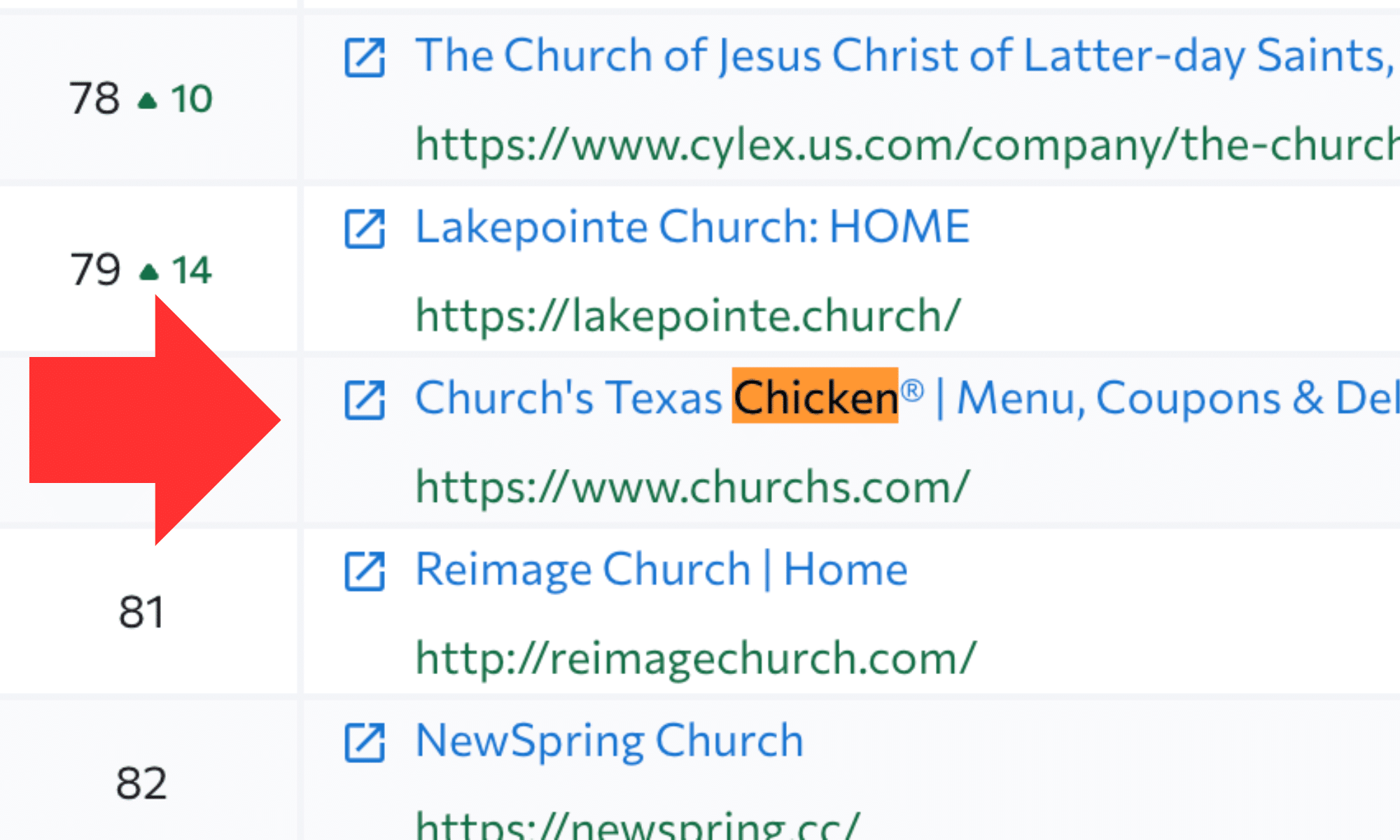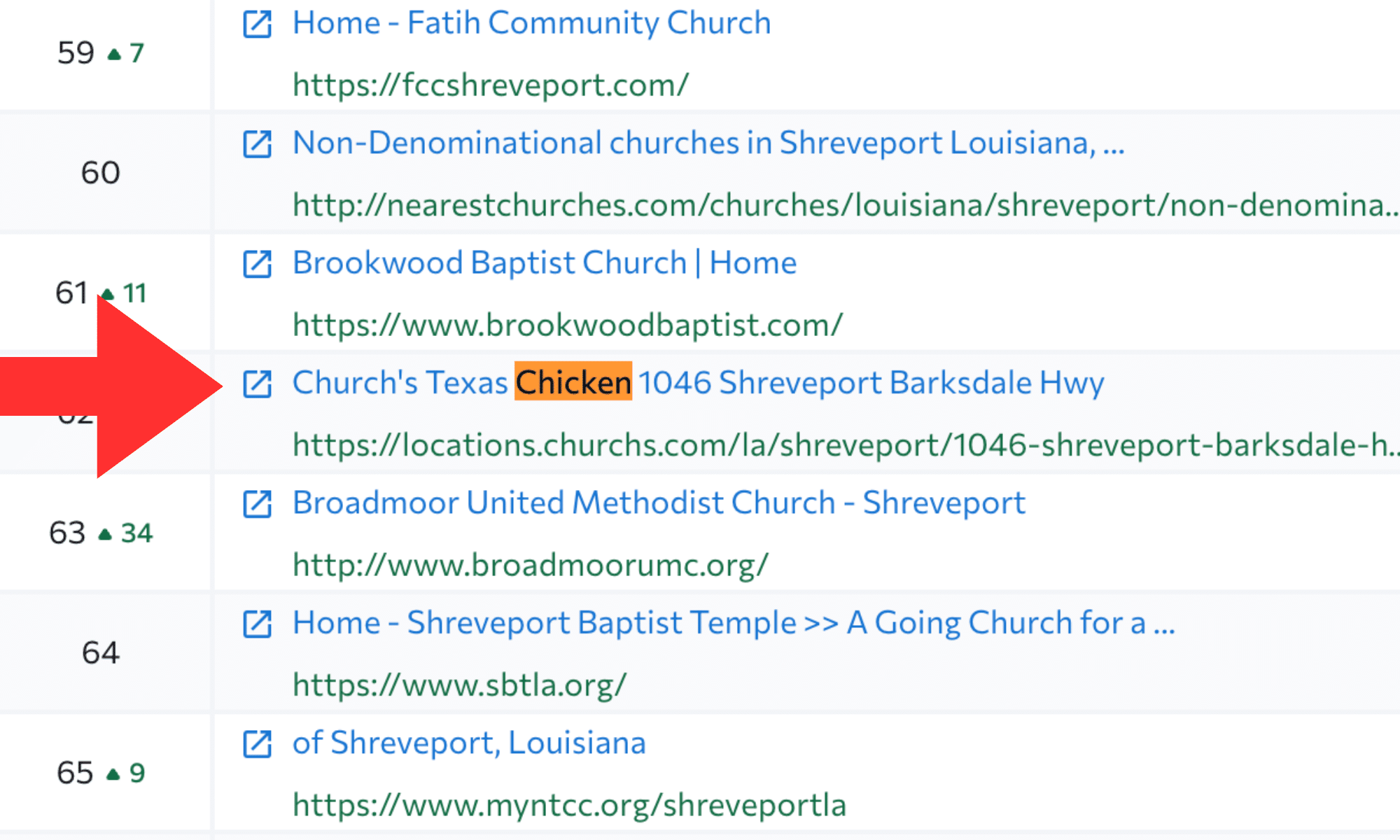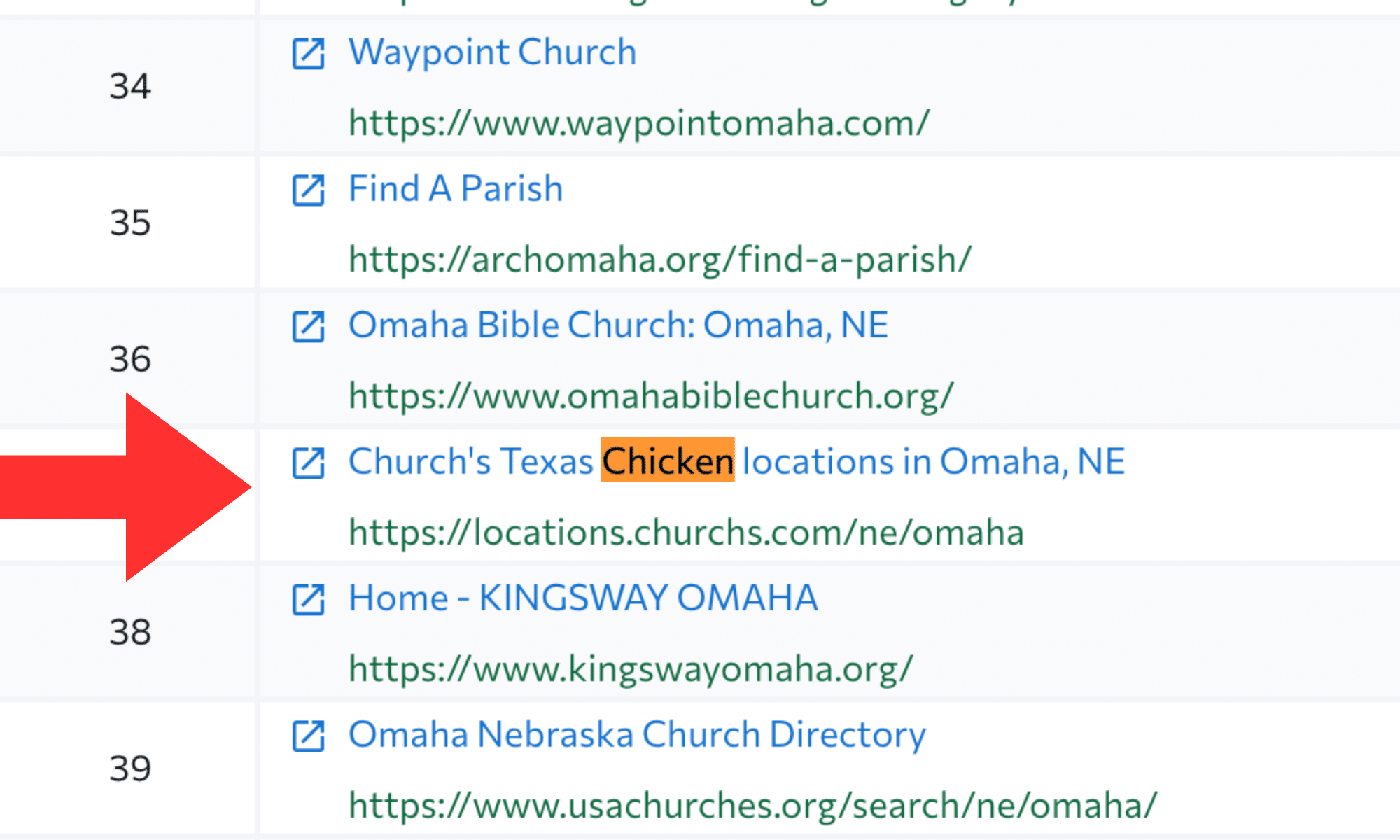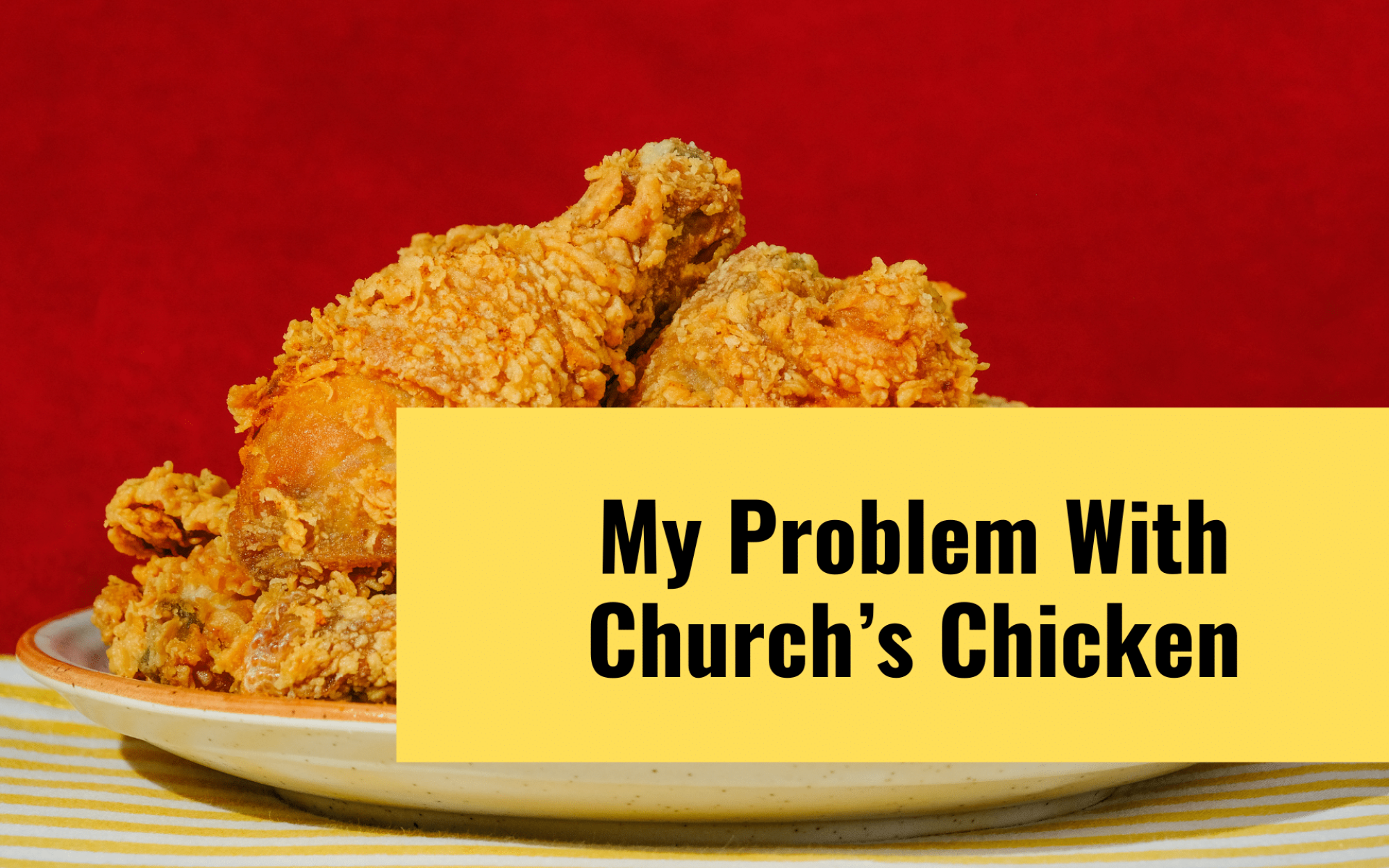I love me some fried chicken.
If you stick a plate of fried chicken in front of me with some creamy mashed potatoes, fried okra, and white gravy — along with a side of Dr. Pepper — I promise you that plate will be gone in less than ten minutes.
Five minutes…if it’s lunch time.
My problem with Church’s Chicken, then, does not come down to its food. I happen to love Church’s Chicken as an eating establishment.
My problem with Church’s Chicken is that it almost always ranks higher than most churches in any given city and state.
That means that if someone isn’t paying attention, they might find themselves getting an early lunch rather than attending worship.
For that reason…I’m not a fan.
The Church’s Chicken Phenomenon
Whenever we start working with a new church, one of our first orders of business is to do a quick scan of their search presence. What keywords do they rank for and where can they improve?
The number one keyword I’m always looking for is “church in [CITY, STATE].” That tells me how high a specific church is ranking when people look for churches to visit in their area.
This is what I see on very regular basis. See how a random “Church’s Chicken” listing appears right in the middle of a search for “churches in Greenville, TX?”

Here’s the same problem in Shreveport, LA

And lest you think it’s just a southern thing, here’s a Church’s Chicken in Omaha, Nebraska that outranks most actual churches in the area.

To be fair, my problem really isn’t with Church’s Chicken the entity, my problem is with how Google sees websites and decides how to rank them. Obviously, someone typing in “churches near me” isn’t looking for a chicken restaurant.
Or are they?
What is Search Intent?
One of the most understated aspects of Search Engine Optimization (SEO) has to do with search intent. What is the searcher looking for, and how can a search engine show it to them?
There are four different classifications that Google makes for searches; each of them represent a different type of intent.
- Informational Intent: A general search query where the user simply wants to learn more about a given subject.
- Navigational Intent: Occurs when a person is looking for a specific webpage, such as “Facebook” or “ Hoka Shoes”
- Commercial Intent: A type of search where someone is researching options for a future transaction.
- Transactional Intent: When the user knows what they want to buy and intends to go directly to the website to make a transaction.
I know none of the above intents would seem to apply to churches, but in reality, all four of them could lead someone to your website under the right circumstances.
- Information Intent: A person looks for more information on the nature of Holy Ghost baptism and finds a blog on your site.
- Navigational Intent: A person has heard about your church and is looking for more information about who you are.
- Commercial Intent: A person is looking for information on “best churches in the area” and finds your website.
- Transactional Intent: A person is looking for a way to contact the preacher at your church with a Bible study.
It seems incredibly carnal to label anything regarding a church as having “commercial intent,” but hopefully you can see the differences in the type of search intent that’s taking place. People want different things from their searches; Google recognizes this, and displays results accordingly.
In all fairness, Google has gotten a lot better at doing this in recent years. It used to be that you could simply load up a URL and/or webpage with target keywords and Google just showed them whatever came up first. As Google has found out more about their users and what they’re actually looking for, however, their search algorithm has matured as well.
How Do I Optimize My Page for Search Intent?
So how do you get a visitor to show up to the front doors of your church expecting a Bible study instead of a three piece combo with a side order of coleslaw?
The answer lies in defining your content strategy.
A lot of people will simply load up their site with “church”-type words and not really give much thought to what they’re actually conveying to their audience. If you step back and look at your page and look at it from a robot’s perspective, what do you see?
Not “what do you think you see,” but what do you actually see?
Are there any mentions of service times? Any statements of faith? Any descriptions of the communion practices?
From a purely technical perspective, it can be difficult for a computer to understand the difference between “elders” and “staff managers,” so make sure you actually have those types of labels on your page.
From there, it’s all about the content.
Think of the Page as a Whole
Search intent is all about looking at your webpage from a holistic standpoint.
(Contrary to popular belief, search engines do not rank entire sites, only webpages. Although there’s no question the twain are interconnected.)
Instead of just writing from stream of consciousness, take a few minutes to actually consider what you’re going to put on your page. Make sure it has all the necessary components, links, and pictures that describe all the various facets of your church.
The more information you put on your webpage, the better. Which leads me to my second point…
Put More Content On Your Page
The number one mistake I see churches making with their SEO is lack of content on their webpage.
I regularly see websites that have not just a few hundred words on their homepage…but maybe a few dozen.
Sine search engines detect what a website is all about through their content, it’s virtually impossible for them to know what is on your site if there’s no content to begin with.
I’m not saying you should load up your site with a bunch of useless junk — which can come across as spammy — but you should absolutely put more content on your site. Homepage, blogs, about us — whatever. Just get it on there (within reason, of course).
Your site will almost always instantly improve.
Think About Sub Categories
If you’re committed to putting more content on your webpage, the next question would logically be “what kind of content should I put on my website?”
The answer: Subcategories.
Take your “About” page, for instance. I’m sure most people reading this will have information about the preacher/elders/deacons, service times, and maybe a brief history.
But think about what else you can add that describes your church AND that visitors might need, such as parking information, pictures, past sermon series and events, maybe even a “mission” statement (which could be as simple as a verse).
One item that works really well is a frequently asked questions (FAQ) section near the bottom. Put questions on there that you know people ask about who you are, such as “why communion every Sunday” and “where’s the guitar?”
Those types of question not only perform well on search engines, but they also anticipate visitors’ questions — and answer them! — before they ever walk through your doors.
BRB Going to Get Chicken Now
All this talk about Church’s Chicken has gotten me hungry, but I hope it’s been a quick glimpse into the power of search intent.
Even for experienced online marketers, search intent is often ignored, so embracing it at whatever stage you are now will set you up with a great foundation for future growth.


